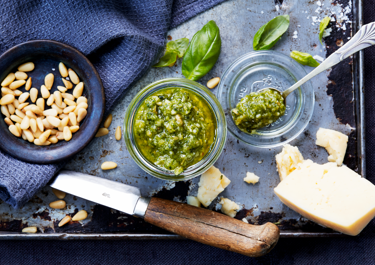
Pesto

Instructions
Pesto
Ingredients
Pesto
Pine nuts | 25 g |
|---|---|
Or roughly 20 g fresh basil | 1 bunch |
Garlic cloves | 2 |
Oil | 100 ml |
Svecia cheese | 100 g |
Salt | ¼ tsp |
Pepper | 1 pinch |
The secret to perfect homemade pesto
Mastering the art of pesto will make you a hero in the kitchen. Start by choosing high quality ingredients. Especially the oil will determine much of the character of your pesto. A nice olive oil will bring deep, authentic flavour. Prepare your basil by washing it thoroughly and letting it dry before blending the sauce. Make sure to toast the pine nuts to a light brown colour, bringing out their delicate nutty flavour. Also, add a little garlic at a time and taste along the way to avoid the garlic overpowering your pesto.
Try red pesto
Not all pesto is green. By adding sun-dried tomatoes and roast red peppers, your pesto takes on a red-brown colour and new flavour dimensions. Just like with the green pesto alla Genovese, there is room for experimentation with a pesto rosso. You can try different kinds of nuts, cheese, and oil. You can also spice things up by adding chilli flakes to the mix, or swap the regular olive oil for chilli oil.
What to serve with pesto
Once you know the delight of homemade pesto, there are no limits to your enjoyment. Pesto is best friends with pasta, but goes well with almost any dish. It’s an excellent, flavourful garnish for meat and fish – or you can toss roasted vegetables in pesto and serve as a satisfying side. Try drizzling it over soup or salads or incorporate it in a dressing. It’s also great for adding authentic refinement to pizza and bruschetta. You can even spread some fresh pesto on a piece of bread to enjoy as a late-night snack.










